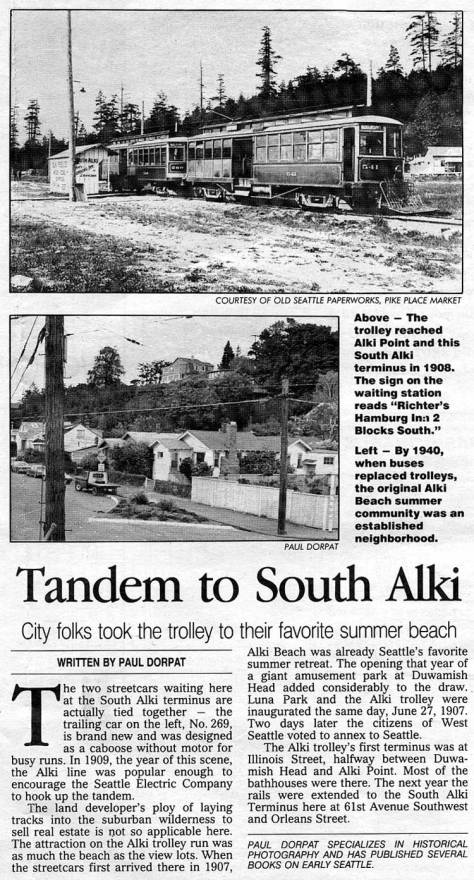(click to enlarge photos)


In today’s “now” scene, West Seattle’s savvy Bob Carney poses for Jean Sherrard on Point Place Southwest, a short block that leads from Alki Avenue Southwest and dead-ends at the green campus of the Alki Point Lighthouse. Its light first penetrated the ordinarily peaceable waters of Puget Sound in 1913 after the federal lighthouse service bought much of the Point from the Hanson-Olson clan who had purchased it in 1868 from Seattle pioneer Doc Maynard.

In his hands, Carney holds a copy of our “then” photo as part of bound pages of his research into the life of the first Alki Natatorium, the landmark featured in the photo. (Derived from Latin, “natatorium” denotes a building that houses a swimming pool. Aficionados abbreviate it as “nat.”)





Years ago, while delivering an admittedly half-baked lecture on West Seattle history to its historical society, I was asked if I had evidence of this early human aquarium. Like many others attending, I imagined that the question was about the later Alki Natatorium, built nearly a mile up Alki Beach from the Point, just east of the Alki Bathhouse, and opened in 1934 with “Seattle’s own swimming champion, Helene Madison, as permanent instructress.” Bob




Carney’s research reveals that the earlier and largely forgotten natatorium at the Point was equipped with “gymnasium paraphernalia” and featured a “bathing tank” 130 feet long, 53 feet wide and from 22 inches to 9-1/2 feet deep, filled daily with Puget Sound waters kept at 74 to 76 degrees. The east end of pavilion, the part showing here with five gables hosted a variety events, most involving dance. The structure was appointed like a Japanese
teahouse – note the hanging lanterns – and its demise was equally exotic. Like the dome atop Seattle’s St. James Cathedral on First Hill, the roof on West Seattle’s first oversized swimming pool collapsed Feb. 1-2, 1916, under what remains Seattle’s deepest (or second deepest – it is debated) 24-hour snowfall.


Soon after Bob showed me this print, researcher Ron Edge found five others (all of them already inserted above) while visiting the Museum of History and Industry library to help make detailed scans of many of its classics. Most likely, all were recorded together in 1905 when the nat was a brand new enterprise undertaken by the Alki Point Transportation Company. Nearly a decade before the Alki Lighthouse arose, in 1904 the company had built both the natatorium and the steamer Dix to render hourly service between this, the firm’s new West Seattle attraction, and Seattle’s central waterfront. (The Dix notoriously sank in November 1906 in a collision killing more than 40 of its estimated 77 passengers.)

We conclude with a too-short nod to the many heroes of local heritage who volunteer with the dozen or so Seattle and King County societies that nurture and share our history. Using our example, Bob Carney is described by Clay Eals, executive director of the Southwest Seattle Historical Society, as “a stalwart volunteer for us over the past three decades, doing everything from serving on our collections committee (evaluating submitted artifacts for possible accession) to putting up exhibits at our Log House Museum. Behind it all is a heart of unrivaled size.”


WEB EXTRAS
Another few laps, lads? Jean, Ron and I are pleased to exersize with you. Below are a line-up of West Seattle features previously printed Pacific and so shown here, some of them recently. We will also insert a few relevant others.
=====

=====
=====
=====
=====



























